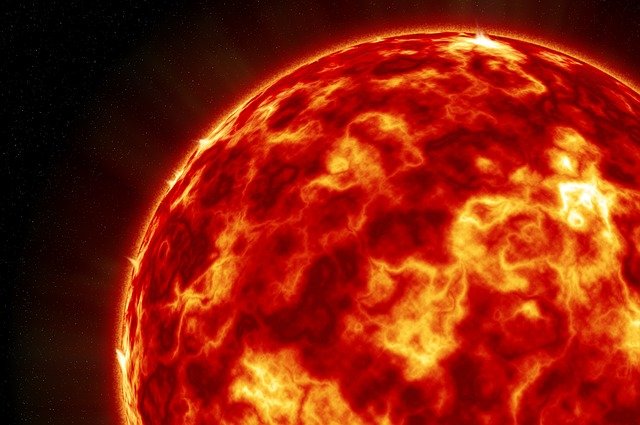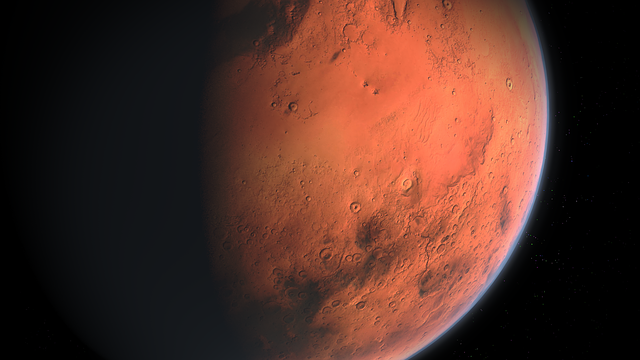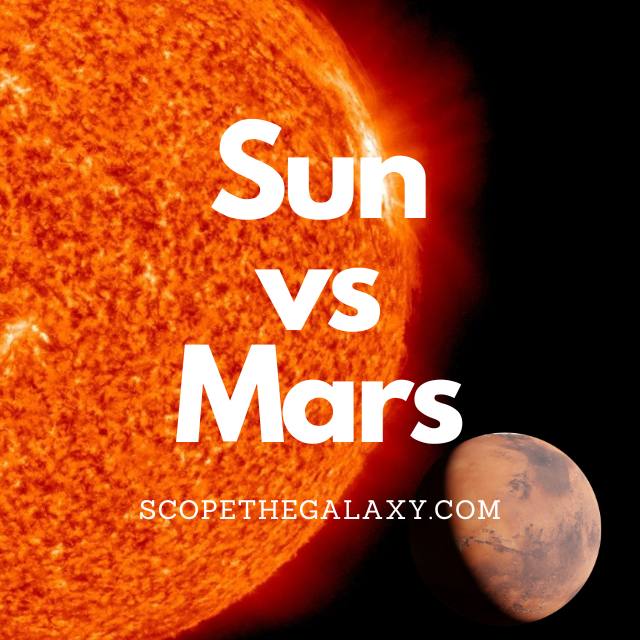*This post may contain affiliate links. This means we may make a commission if you purchase an item using one of our links*
The main differences between the Sun and Mars is that the Sun is a main sequence yellow dwarf star that is able to produce energy via nuclear fusion, is extremely bright and is roughly 1.39 million km in size whereas Mars is the 4th farthest planet from the Sun, that is 6,779km in diameter, is red in color.and has 2 moons orbiting whilst also orbiting the Sun itself.
There are a variety of other differences between these two celestial beings so continue reading for a breakdown on both entities, the similarities and the differences between the two.
What Is The Sun?
Table of Contents

The Sun is the bright, celestial entity at the center of our solar system and is also a star that falls under the G type main sequence star bracket (also called a yellow dwarfs), all of which are medium sized stars that tend to be around 0.84 – 1.15 solar masses.
Our Sun is 1 solar mass, making it a medium sized medium star. It’s also on the brighter side for a yellow dwarf, the color that it emits is white as opposed to the slightly yellow that less luminous yellow dwarfs would be.
Of course we still see the Sun as yellow or even red on Earth but, the reason for this significant color shift is because our atmosphere scatters and breaks up the photons that reach us, ultimately changing the true color of the light rays from white to the yellow, orange or red we see in our day to day.
As it is a star, the Sun will actively convert the hydrogen elements at its core into helium, through a process called nuclear fusion.
Nuclear fusion is the reason why it generates light and produces the energy we receive, helping us power machinery, technology, grow crops so on and so forth.
The process of nuclear fusion also affects how hot our star burns, allowing the sun to hit temperatures around 6000°C on a daily basis. This will be the case for another 4.5 – 5 billion years until it’s unable to convert hydrogen into helium.
Once hydrogen cannot be converted, an imbalance between the inward and outward forces keeping the Sun together will occur, causing an imbalance which would result in our Sun bloating up many many times its current size.
When this happens it will enter its red giant phase, where it’ll be around 256 times larger than it is now.
This phase will last for around a billion years until it sheds it mass through a process called planetary nebula, leaving behind only a dead white dwarf remnant.
What Is The Planet Mars?

Mars, also known as the red planet, is the celestial object that’s the front runner in our entire solar system to become a possible new home for us if terraformed. It is also the 4th farthest planet from the Sun and is one of 4 main line
terrestrial planets (not including Pluto) in our solar system.
This means that one year on Mars will take roughly 687 Earth days and a day on Mars is roughly the same as Earth at 24 hours and 37 minutes. It’s axial tilt is also very similar to that of Earth where it is positioned around 25 degrees to the right.
It may not be the largest terrestrial world in our solar system as its diameter is only 6,779km but, it does have the most moons amongst the normal terrestrial planet where two, namely Deimos and Phobos, are currently orbiting the red planet.
Like Earth and the other terrestrial worlds, Mars does have an atmosphere, certainly more visible than that on Mercury but, when compared to Earth’s it is merely 1% of its volume.
As a result it is more susceptible to larger debris striking its surface and is unable to trap in too much heat either. This is why it’s on the colder side with a temperature of around -65 degrees Celsius on average. On the contrary its core is significantly hotter at 1,350 degrees Celsius.
Mars is probably the most explored planet outside of our own, with a multitude of rovers like Sojourner (1997–1997), Opportunity (2004–2018), Spirit (2004–2010), Curiosity (2012–), and Perseverance (2021–) that have landed on the Martian soil to explore it.
Billionaires like Elon Musk and even Jeff Bezos are trying for an opportunity to genuinely have astronauts land on the Martian soil, possibly as early as 2029 so, Mars clearly has a lot interested in its terrain, as a potential substitute for Earth in the future.
How Is The Sun And Mars Similar?
Although Mars and the Sun don’t share too much in common, they do have the odd few features that are similar, which in this case includes the following:
- Both are spherical in shape.
- Both have a hotter central core.
- Both have multiple objects orbiting them.
Differences Between The Sun And Mars
In regards to the differences between the two, they include the following:
- Mars has 2 moons whilst the Sun has Mars along with all the other entities within our solar system orbiting it.
- The Sun is far bigger than Mars with a diameter of 1.39 million km compared to Mars’ 6,779km.
- The Sun goes through the process of nuclear fusion where it converts hydrogen to helium whereas Mars is unable to do this as it is not a star.
- The Sun is far brighter than Mars.
- The Sun’s magnetic field strength is superior to Mars too where it stand at 1 gauss as opposed to Mars’ which is around 40 times weakers than Earth’s that stands at around 0.25–0.65 guass.
- Mars is red in color whilst the Sun is white.
- The Sun is far hotter than Mars with a surface temperature of around 6,000 degrees Celsius whereas Mars is around -67 degrees Celsius.
- Mars does not have a set lifespan whilst the Sun is estimated to have a lifespan of 10 billion before it will go through a planetary nebula phase and become a white dwarf.
- The Sun has far more mass than Mars where it is equal to 1 solar mass or 1.989 x 10^30 compared to Mars’ that is 6.39 × 10^23 kg.
- Mars has a density of 3.93 g/cm³ whereas the Sun has a density of 1.41 g/cm³.
- In regards to the differences in gravity, Mars has a gravity of 3.721 m/s² whereas the Sun has a far stronger gravity of 274 m/s².
Summary
Mars and the Sun are very differnet entiteis from one another where one is a normal terrestrial planet and the other the center of any given solar system inlcuding the one that Mars orbits.
The Sun is a main sequences star that creates energy that is supplied all throughout our solar system and is many times brighter, hotter and bigger than Mars. Besides the two are in completely different brackets when it comes to celestial beings therefore, it makes sense that there are so many differences between the two.


